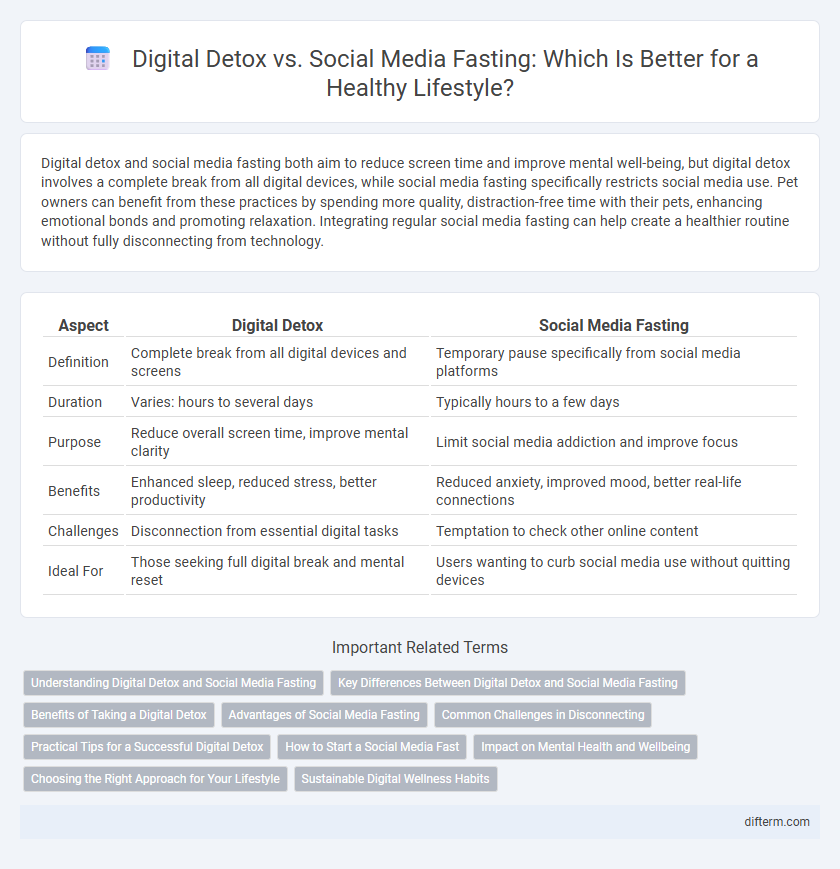Digital detox and social media fasting both aim to reduce screen time and improve mental well-being, but digital detox involves a complete break from all digital devices, while social media fasting specifically restricts social media use. Pet owners can benefit from these practices by spending more quality, distraction-free time with their pets, enhancing emotional bonds and promoting relaxation. Integrating regular social media fasting can help create a healthier routine without fully disconnecting from technology.
Table of Comparison
| Aspect | Digital Detox | Social Media Fasting |
|---|---|---|
| Definition | Complete break from all digital devices and screens | Temporary pause specifically from social media platforms |
| Duration | Varies: hours to several days | Typically hours to a few days |
| Purpose | Reduce overall screen time, improve mental clarity | Limit social media addiction and improve focus |
| Benefits | Enhanced sleep, reduced stress, better productivity | Reduced anxiety, improved mood, better real-life connections |
| Challenges | Disconnection from essential digital tasks | Temptation to check other online content |
| Ideal For | Those seeking full digital break and mental reset | Users wanting to curb social media use without quitting devices |
Understanding Digital Detox and Social Media Fasting
Digital detox involves a comprehensive break from all forms of digital technology to reduce stress and improve mental clarity, while social media fasting specifically targets the temporary avoidance of social media platforms to regain focus and emotional balance. Both practices aim to enhance well-being by minimizing digital distractions, but digital detox encompasses a broader range of devices and applications beyond social media. Understanding these distinctions helps individuals choose the appropriate strategy for managing screen time and fostering healthier digital habits.
Key Differences Between Digital Detox and Social Media Fasting
Digital detox involves a comprehensive break from all digital devices, including smartphones, computers, and tablets, to reduce overall screen time and mental fatigue. Social media fasting targets only social media platforms, allowing continued use of other digital tools while specifically minimizing exposure to social media content. The key difference lies in the scope: digital detox promotes complete digital disconnection, whereas social media fasting focuses on curbing the influence of social networking sites.
Benefits of Taking a Digital Detox
Taking a digital detox improves mental clarity by reducing screen time and minimizing digital distractions, leading to enhanced focus and productivity. It promotes better sleep quality through decreased exposure to blue light emitted by devices, supporting overall health and well-being. Engaging in a digital detox also fosters deeper personal connections and mindfulness by encouraging real-world interactions without the interference of social media notifications.
Advantages of Social Media Fasting
Social media fasting offers targeted advantages such as reducing screen time, improving mental clarity, and enhancing productivity by minimizing digital distractions. It promotes healthier sleep patterns and decreases anxiety linked to social media overuse. This focused approach encourages mindful content consumption and fosters deeper real-life connections.
Common Challenges in Disconnecting
Digital detox and social media fasting both face common challenges such as habitual checking behaviors, fear of missing out (FOMO), and the stress of digital withdrawal. Users often experience anxiety and decreased productivity due to constant notifications and the ingrained habit of multitasking across apps. Overcoming these obstacles requires mindful strategies, including setting clear boundaries, scheduling offline activities, and gradually reducing screen time to minimize withdrawal symptoms.
Practical Tips for a Successful Digital Detox
Set clear boundaries by designating specific times or areas where digital devices are not allowed, such as during meals or before bedtime, to reduce screen dependency effectively. Replace online activities with offline hobbies like reading, walking, or journaling to maintain engagement and distract from digital cravings. Use apps that track and limit screen time to monitor progress and stay accountable throughout the digital detox period.
How to Start a Social Media Fast
Begin a social media fast by setting clear goals and defining the duration, such as a day, weekend, or week, to create manageable boundaries. Delete or temporarily disable social media apps on your devices to minimize temptation and use alternative activities like reading or outdoor exercise to fill your time. Inform friends and family about your fast to build support and reduce the pressure to check updates frequently.
Impact on Mental Health and Wellbeing
Digital detox involves completely disconnecting from all electronic devices, leading to significant reductions in stress and anxiety by removing constant digital stimuli. Social media fasting targets specific platforms, helping to decrease social comparison and improve mood regulation without cutting off essential digital communication. Both approaches contribute to enhanced mental health and overall wellbeing by promoting mindfulness and reducing digital burnout.
Choosing the Right Approach for Your Lifestyle
Digital detox involves completely disconnecting from electronic devices to reduce stress and improve mental clarity, while social media fasting targets limiting time spent on platforms without entirely avoiding digital tools. Assessing personal habits, professional demands, and mental health goals helps determine whether a full digital detox or a social media fast aligns better with your lifestyle. Tailoring the approach ensures sustainable habits that enhance well-being without sacrificing productivity or connectivity.
Sustainable Digital Wellness Habits
Digital detox involves complete disconnection from all digital devices for a set period, promoting mental clarity and reducing screen fatigue, while social media fasting specifically targets abstaining from social platforms to alleviate anxiety and improve focus. Sustainable digital wellness habits emphasize regular, intentional breaks from technology combined with mindful usage practices, enabling long-term balance without sacrificing connectivity. Incorporating strategies such as scheduled offline times, app usage limits, and mindfulness techniques supports lasting improvements in mental health and productivity.
Digital detox vs Social media fasting Infographic

 difterm.com
difterm.com